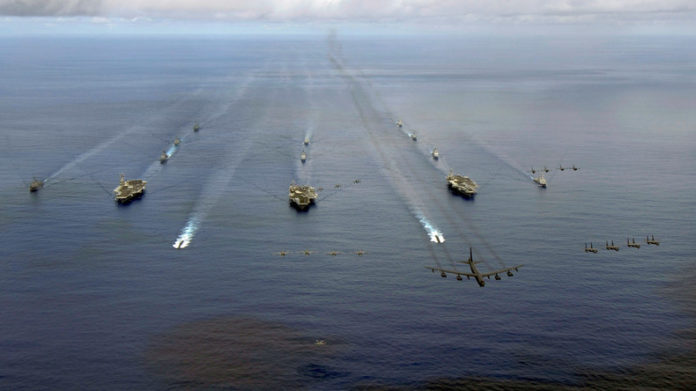
Disabled a few years ago on the grounds that Russia is no longer a military threat, the fleet, which was intended to deploy US tanks and soldiers quickly to Europe in the event of deployment, should be put back into operation.
As Russia slashes its military spending by 20 percent, the Pentagon announces it will reopen the Second US Fleet, pointing to an alleged new threat posed by Russia. However, Russia is hardly present in the intended area of operation of the Second Fleet, the North Atlantic, to this day.
Peace researchers: NATO military spending at record high while Moscow cuts spending by 20 percent
Nonetheless, US Navy Chief of Staff US Admiral John M. Richardson argues that the world has “entered a new era of competition between the major powers.”
To prepare for these changes, especially in the North Atlantic, we are reissuing the Second Fleet today, “Richardson said symbolically on May 5 aboard aircraft carrier USS George H. W. Bush.

Only seven years ago, the US had deactivated the Second Fleet on the grounds that Russia was no longer a military threat.
As the headquarters of the Association, according to current information, the US naval base Norfolk in the US state of Virginia about 230 kilometers south of Washington, D.C. serve. The Second Fleet had its headquarters there until 2011. Prior to its temporary deactivation, the Second Fleet comprised 126 warships, 4,500 aircraft, and 90,000 Marine soldiers.
British military analyst Jonathan Marcus writes in a post for the BBC about the reactivation of the US Second Fleet:
In this case, the focus is on Russia – a response to the increased naval activity of recent years. The existing pattern of US naval operations will also change significantly. US Secretary of Defense James Mattis insists he wants less predictable missions of shorter duration. Experts also believe that a US aircraft carrier combat group of the fleet is now used more often in European waters.
A look at the history and locations of the Second Fleet does not bode well for the fragile world peace:
1. Transfer of war equipment and US soldiers to Europe as the main task
One of the tasks of the Second US Fleet during the Cold War was to ensure the rapid transfer of US tanks and soldiers to Europe. For this purpose, the association was equipped with special landing craft for heavy fighting equipment such as battle tanks and howitzers. According to US Admiral Richardson, the reactivated Second Fleet should resume this “tradition” and be assigned more “amphibious forces”.
2. Second Fleet attack on Soviet submarine
As part of the Cuban missile crisis in 1962, operational control of the so-called quarantine unit was transferred to the commanding officer of the Second Fleet, Vice Admiral Alfred G. Ward, who organized Task Force 136 for this purpose. In this context, there was a hitherto little known direct confrontation between a US submarine fighter and a Soviet submarine. On October 27, 1962, an American Destroyer of the Second Fleet attacked a Soviet submarine B-59 off Cuba with depth charges to force it to the surface, unaware that it had nuclear torpedoes.
More on the topic – Russian analysts: West is heading for the world with Skripal case on Cuba crisis 2.0
Wadim Orlov, a member of the then-submarine crew, explained at a 2002 technical conference on the Cuban missile crisis in Havana that the submarine was authorized to fire when the three senior officers agreed. The officers began a heated debate over whether to sink the US cruiser. Two of them said yes and no.
A guy named Arkhipow saved the world “,
commented the renowned US historian Thomas Blanton of George Washington University the incident.
3. Lead in international invasions
In October 1983, US President Ronald Reagan ordered the Second Fleet to the Caribbean to lead the illegal invasion of Grenada during Operation Urgent Fury. The amphibious units for the operation consisted of the amphibious attack ship USS Guam (LPH-9), the amphibious transport ship USS Trenton (LPD-14), the dock landing ship USS Fort Snelling (LSD-30), the USS Manitowoc tanker (LST-1180) and USS Barnstable County (LST-1197) as well as the 22nd amphibious invasion unit of the US Navy.
The then commanding officer for the invasion, Vice Admiral Joseph Metcalf, instructed the Amphibious Landing Force, Task Force 124, to occupy Pearls Airport and the new airport near Point Salines and the Port of Grenville, and all opposing forces in the area “Neutralize” the area.
Background of the attack
On the Caribbean island, a government that was not friendly to the US came to power and maintained good relations with Cuba. The new prime minister Maurice Bishop expropriated some businesses and implemented several social reforms, such as the introduction of a state-funded health system and the construction of many schools and other infrastructure projects. Cuba helped the lower-developed Caribbean island through the construction of a $ 50 million airport. Cuba provided 636 construction workers and secured half of the construction costs. US President Reagon gave the attack order to the Second Fleet for allegedly fearing “misuse of the airport for military purposes.” In the invasion, 25 Cuban construction workers were killed.
The United Nations Security Council voted by a large majority on 28 October 1983 for a resolution calling the US invasion “a grave violation of international law” and expressing “the UN’s deep regret”. The United States immediately vetoed this resolution. Ronald Reagan’s telling answer to the resolution was:
“One hundred nations in the UN disagreed with just about everything that happened to them where we were involved, and it did not disturb my breakfast in any way.”




